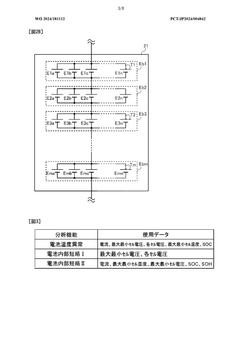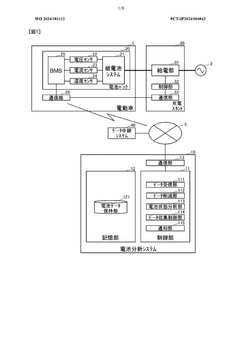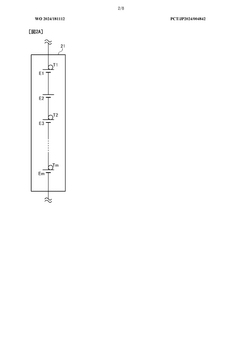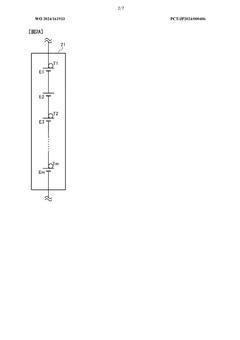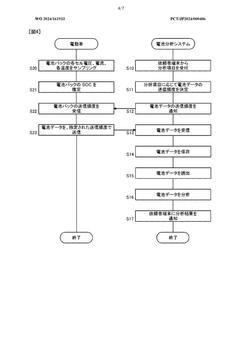Impact of Advanced Data Analytics on Battery Management Systems
AUG 8, 20259 MIN READ
Generate Your Research Report Instantly with AI Agent
Patsnap Eureka helps you evaluate technical feasibility & market potential.
Analytics in BMS: Background and Objectives
Battery Management Systems (BMS) have been integral to the efficient operation and safety of battery-powered devices and vehicles for decades. As the demand for electric vehicles and renewable energy storage solutions continues to grow, the role of BMS has become increasingly critical. Advanced data analytics is now emerging as a game-changing factor in the evolution of BMS technology, promising to revolutionize how we monitor, manage, and optimize battery performance.
The primary objective of integrating advanced data analytics into BMS is to enhance battery life, improve safety, and maximize overall system efficiency. By leveraging sophisticated algorithms and machine learning techniques, modern BMS can process vast amounts of real-time data to make more accurate predictions and decisions about battery health and performance.
Historically, BMS relied on relatively simple voltage, current, and temperature measurements to estimate battery state and protect against overcharging or discharging. However, as battery technologies have become more complex and energy-dense, traditional methods have proven insufficient to fully capture the intricacies of battery behavior under various conditions.
The advent of big data and advanced analytics has opened up new possibilities for BMS. These systems can now collect and analyze a much broader range of parameters, including individual cell voltages, internal resistance, charge/discharge cycles, and even environmental factors. This wealth of data, when properly analyzed, can provide unprecedented insights into battery performance and degradation patterns.
One of the key goals of implementing advanced analytics in BMS is to develop more accurate state estimation techniques. This includes improved methods for determining the State of Charge (SoC), State of Health (SoH), and State of Power (SoP) of batteries. By employing machine learning algorithms, BMS can now adapt to changing battery characteristics over time, leading to more precise and reliable estimations throughout the battery's lifecycle.
Another critical objective is to enhance predictive maintenance capabilities. Advanced analytics enable BMS to detect subtle changes in battery behavior that may indicate impending failures or performance degradation. This proactive approach allows for timely interventions, potentially extending battery life and reducing the risk of catastrophic failures.
Furthermore, the integration of data analytics aims to optimize charging strategies. By analyzing historical usage patterns and environmental data, BMS can implement adaptive charging algorithms that balance the need for rapid charging with the goal of minimizing battery degradation. This is particularly crucial for electric vehicles, where charging speed and battery longevity are key consumer concerns.
As we look towards the future, the objectives of advanced analytics in BMS extend beyond individual battery management to encompass entire energy ecosystems. There is growing interest in using BMS data to optimize grid-level energy storage systems, improve the integration of renewable energy sources, and enhance the overall efficiency of smart grids.
The primary objective of integrating advanced data analytics into BMS is to enhance battery life, improve safety, and maximize overall system efficiency. By leveraging sophisticated algorithms and machine learning techniques, modern BMS can process vast amounts of real-time data to make more accurate predictions and decisions about battery health and performance.
Historically, BMS relied on relatively simple voltage, current, and temperature measurements to estimate battery state and protect against overcharging or discharging. However, as battery technologies have become more complex and energy-dense, traditional methods have proven insufficient to fully capture the intricacies of battery behavior under various conditions.
The advent of big data and advanced analytics has opened up new possibilities for BMS. These systems can now collect and analyze a much broader range of parameters, including individual cell voltages, internal resistance, charge/discharge cycles, and even environmental factors. This wealth of data, when properly analyzed, can provide unprecedented insights into battery performance and degradation patterns.
One of the key goals of implementing advanced analytics in BMS is to develop more accurate state estimation techniques. This includes improved methods for determining the State of Charge (SoC), State of Health (SoH), and State of Power (SoP) of batteries. By employing machine learning algorithms, BMS can now adapt to changing battery characteristics over time, leading to more precise and reliable estimations throughout the battery's lifecycle.
Another critical objective is to enhance predictive maintenance capabilities. Advanced analytics enable BMS to detect subtle changes in battery behavior that may indicate impending failures or performance degradation. This proactive approach allows for timely interventions, potentially extending battery life and reducing the risk of catastrophic failures.
Furthermore, the integration of data analytics aims to optimize charging strategies. By analyzing historical usage patterns and environmental data, BMS can implement adaptive charging algorithms that balance the need for rapid charging with the goal of minimizing battery degradation. This is particularly crucial for electric vehicles, where charging speed and battery longevity are key consumer concerns.
As we look towards the future, the objectives of advanced analytics in BMS extend beyond individual battery management to encompass entire energy ecosystems. There is growing interest in using BMS data to optimize grid-level energy storage systems, improve the integration of renewable energy sources, and enhance the overall efficiency of smart grids.
Market Demand for Smart Battery Management
The market demand for smart battery management systems (BMS) has been experiencing significant growth, driven by the increasing adoption of electric vehicles (EVs) and renewable energy storage solutions. As the global push for cleaner energy and sustainable transportation intensifies, the need for advanced BMS technologies has become more pronounced.
In the automotive sector, the rapid expansion of the EV market has been a primary driver for smart BMS demand. With major automakers committing to electrification of their vehicle lineups, the requirement for sophisticated battery management solutions has surged. These systems are crucial for optimizing battery performance, extending range, and ensuring safety in EVs.
The renewable energy sector has also contributed substantially to the growing demand for smart BMS. As solar and wind power installations increase worldwide, the need for efficient energy storage solutions has become paramount. Smart BMS plays a vital role in managing large-scale battery storage systems, enabling better integration of intermittent renewable energy sources into the power grid.
Consumer electronics represent another significant market segment driving the demand for smart BMS. With the proliferation of smartphones, laptops, and wearable devices, consumers expect longer battery life and faster charging times. Advanced BMS technologies are essential in meeting these expectations while maintaining device safety and longevity.
The industrial sector has shown increasing interest in smart BMS for applications such as uninterruptible power supplies (UPS) and material handling equipment. These systems help improve operational efficiency, reduce downtime, and extend the lifespan of battery-powered equipment in various industrial settings.
Market analysts project robust growth for the smart BMS market in the coming years. Factors such as government regulations promoting clean energy adoption, advancements in battery technology, and the increasing focus on energy efficiency are expected to fuel this growth. Additionally, the integration of artificial intelligence and machine learning capabilities into BMS is anticipated to create new opportunities and further drive market expansion.
As the demand for smart BMS continues to rise, manufacturers are investing heavily in research and development to enhance their product offerings. Key areas of focus include improving battery life prediction algorithms, developing more accurate state-of-charge estimation techniques, and implementing advanced thermal management strategies. These innovations aim to address the evolving needs of various industries and applications relying on battery-powered systems.
In the automotive sector, the rapid expansion of the EV market has been a primary driver for smart BMS demand. With major automakers committing to electrification of their vehicle lineups, the requirement for sophisticated battery management solutions has surged. These systems are crucial for optimizing battery performance, extending range, and ensuring safety in EVs.
The renewable energy sector has also contributed substantially to the growing demand for smart BMS. As solar and wind power installations increase worldwide, the need for efficient energy storage solutions has become paramount. Smart BMS plays a vital role in managing large-scale battery storage systems, enabling better integration of intermittent renewable energy sources into the power grid.
Consumer electronics represent another significant market segment driving the demand for smart BMS. With the proliferation of smartphones, laptops, and wearable devices, consumers expect longer battery life and faster charging times. Advanced BMS technologies are essential in meeting these expectations while maintaining device safety and longevity.
The industrial sector has shown increasing interest in smart BMS for applications such as uninterruptible power supplies (UPS) and material handling equipment. These systems help improve operational efficiency, reduce downtime, and extend the lifespan of battery-powered equipment in various industrial settings.
Market analysts project robust growth for the smart BMS market in the coming years. Factors such as government regulations promoting clean energy adoption, advancements in battery technology, and the increasing focus on energy efficiency are expected to fuel this growth. Additionally, the integration of artificial intelligence and machine learning capabilities into BMS is anticipated to create new opportunities and further drive market expansion.
As the demand for smart BMS continues to rise, manufacturers are investing heavily in research and development to enhance their product offerings. Key areas of focus include improving battery life prediction algorithms, developing more accurate state-of-charge estimation techniques, and implementing advanced thermal management strategies. These innovations aim to address the evolving needs of various industries and applications relying on battery-powered systems.
Current Challenges in BMS Data Analytics
Battery Management Systems (BMS) are critical components in modern energy storage solutions, particularly in electric vehicles and renewable energy systems. As these systems become more complex and data-intensive, the integration of advanced data analytics presents both opportunities and challenges. Current BMS data analytics face several significant hurdles that need to be addressed to fully leverage the potential of these technologies.
One of the primary challenges is the sheer volume and complexity of data generated by modern battery systems. BMS collect vast amounts of information on voltage, current, temperature, and other parameters across numerous cells and modules. Processing and analyzing this data in real-time to make accurate predictions and decisions is computationally intensive and requires sophisticated algorithms and hardware.
Data quality and reliability pose another significant challenge. Sensor errors, communication failures, and environmental factors can introduce noise and inconsistencies into the data stream. Ensuring the accuracy and integrity of data inputs is crucial for reliable analytics, yet it remains a complex task in dynamic operating conditions.
The heterogeneity of battery systems and operating environments further complicates data analytics efforts. Different battery chemistries, form factors, and usage patterns result in diverse data characteristics and behaviors. Developing analytics models that can generalize across this variety while maintaining accuracy is a formidable challenge.
Predictive analytics for battery health and performance is an area of intense focus but faces limitations in long-term accuracy. Current models struggle to account for the complex interplay of factors affecting battery degradation over extended periods, leading to uncertainties in lifetime predictions and optimal usage strategies.
Real-time decision-making based on data analytics is another frontier with significant challenges. Balancing the need for rapid response with the computational demands of complex analytics algorithms requires careful optimization and often involves trade-offs between accuracy and speed.
Data security and privacy concerns also present challenges in BMS data analytics. As battery systems become more connected and data-driven, protecting sensitive information and ensuring compliance with data protection regulations become critical considerations in analytics system design.
Lastly, the integration of BMS data analytics with broader energy management systems and smart grid infrastructure introduces interoperability challenges. Standardizing data formats, communication protocols, and analytics interfaces across diverse platforms and vendors remains an ongoing effort in the industry.
Addressing these challenges requires interdisciplinary approaches combining expertise in battery technology, data science, machine learning, and systems engineering. As the field evolves, overcoming these hurdles will be crucial in realizing the full potential of advanced data analytics in Battery Management Systems.
One of the primary challenges is the sheer volume and complexity of data generated by modern battery systems. BMS collect vast amounts of information on voltage, current, temperature, and other parameters across numerous cells and modules. Processing and analyzing this data in real-time to make accurate predictions and decisions is computationally intensive and requires sophisticated algorithms and hardware.
Data quality and reliability pose another significant challenge. Sensor errors, communication failures, and environmental factors can introduce noise and inconsistencies into the data stream. Ensuring the accuracy and integrity of data inputs is crucial for reliable analytics, yet it remains a complex task in dynamic operating conditions.
The heterogeneity of battery systems and operating environments further complicates data analytics efforts. Different battery chemistries, form factors, and usage patterns result in diverse data characteristics and behaviors. Developing analytics models that can generalize across this variety while maintaining accuracy is a formidable challenge.
Predictive analytics for battery health and performance is an area of intense focus but faces limitations in long-term accuracy. Current models struggle to account for the complex interplay of factors affecting battery degradation over extended periods, leading to uncertainties in lifetime predictions and optimal usage strategies.
Real-time decision-making based on data analytics is another frontier with significant challenges. Balancing the need for rapid response with the computational demands of complex analytics algorithms requires careful optimization and often involves trade-offs between accuracy and speed.
Data security and privacy concerns also present challenges in BMS data analytics. As battery systems become more connected and data-driven, protecting sensitive information and ensuring compliance with data protection regulations become critical considerations in analytics system design.
Lastly, the integration of BMS data analytics with broader energy management systems and smart grid infrastructure introduces interoperability challenges. Standardizing data formats, communication protocols, and analytics interfaces across diverse platforms and vendors remains an ongoing effort in the industry.
Addressing these challenges requires interdisciplinary approaches combining expertise in battery technology, data science, machine learning, and systems engineering. As the field evolves, overcoming these hurdles will be crucial in realizing the full potential of advanced data analytics in Battery Management Systems.
Existing Data-Driven BMS Approaches
01 Data analytics for battery performance optimization
Battery Management Systems utilize data analytics to optimize battery performance. This involves analyzing various parameters such as charge/discharge cycles, temperature, and voltage to predict battery health, improve efficiency, and extend battery life. Advanced algorithms process large datasets to provide insights for better battery management and operational decisions.- Data analytics for battery performance optimization: Battery Management Systems utilize data analytics to optimize battery performance. This involves analyzing various parameters such as charge/discharge cycles, temperature, and voltage to predict battery health, improve efficiency, and extend battery life. Advanced algorithms process large datasets to provide insights for better battery management and operational decisions.
- Predictive maintenance using machine learning: Machine learning algorithms are employed in Battery Management Systems to predict maintenance needs and potential failures. By analyzing historical data and real-time sensor inputs, these systems can forecast battery degradation, identify anomalies, and schedule preventive maintenance, reducing downtime and extending battery lifespan.
- Real-time monitoring and diagnostics: Battery Management Systems incorporate real-time monitoring and diagnostic capabilities. These systems continuously collect and analyze data from various sensors to provide instant insights into battery health, performance, and potential issues. This enables quick response to anomalies and helps in maintaining optimal battery conditions.
- Energy management and load balancing: Data analytics in Battery Management Systems facilitate efficient energy management and load balancing. By analyzing usage patterns, energy demand, and available battery capacity, these systems optimize energy distribution, manage peak loads, and improve overall system efficiency in applications such as electric vehicles and grid storage.
- Integration with IoT and cloud computing: Battery Management Systems leverage Internet of Things (IoT) connectivity and cloud computing for enhanced data analytics. This integration allows for remote monitoring, data aggregation from multiple sources, and advanced analytics using cloud-based resources. It enables scalable data processing, improved decision-making, and the development of more sophisticated battery management strategies.
02 Predictive maintenance using machine learning
Machine learning algorithms are employed in Battery Management Systems to predict maintenance needs and potential failures. By analyzing historical data and real-time sensor inputs, these systems can forecast battery degradation, identify anomalies, and schedule preventive maintenance, reducing downtime and extending battery lifespan.Expand Specific Solutions03 Energy management and load balancing
Data analytics in Battery Management Systems enable efficient energy management and load balancing. By analyzing usage patterns, energy demand, and available battery capacity, these systems can optimize power distribution, manage peak loads, and integrate with renewable energy sources for improved overall system performance.Expand Specific Solutions04 Real-time monitoring and diagnostics
Battery Management Systems incorporate real-time monitoring and diagnostics capabilities using data analytics. This involves continuous analysis of battery parameters, fault detection, and performance evaluation. Advanced visualization tools and dashboards provide operators with actionable insights for immediate decision-making and system optimization.Expand Specific Solutions05 Integration with IoT and cloud computing
Modern Battery Management Systems leverage Internet of Things (IoT) connectivity and cloud computing for enhanced data analytics. This integration allows for remote monitoring, data aggregation from multiple sources, and scalable processing power. Cloud-based analytics enable more sophisticated predictive models and facilitate data-driven decision-making across large-scale battery installations.Expand Specific Solutions
Key Players in Advanced BMS Solutions
The advanced data analytics market for Battery Management Systems (BMS) is in a growth phase, driven by increasing demand for electric vehicles and energy storage solutions. The market size is expanding rapidly, with major players like LG Energy Solution, Panasonic, and BYD Semiconductor leading the charge. These companies are investing heavily in R&D to improve BMS technology, focusing on enhancing battery performance, safety, and longevity. The technology is maturing quickly, with companies like Robert Bosch GmbH and DENSO Corp. integrating advanced analytics into their BMS offerings. Emerging players such as Cuberg and Zitara Technologies are pushing innovation boundaries, particularly in AI-driven predictive maintenance and optimization algorithms for BMS.
LG Energy Solution Ltd.
Technical Solution: LG Energy Solution has developed an advanced Battery Management System (BMS) that leverages data analytics to optimize battery performance and longevity. Their system employs machine learning algorithms to analyze real-time data from battery cells, including voltage, current, and temperature[1]. This allows for predictive maintenance and adaptive charging strategies. The BMS uses historical data to create detailed battery health models, enabling accurate state-of-charge and state-of-health estimations[3]. Additionally, LG has implemented edge computing capabilities in their BMS, allowing for faster data processing and reduced latency in critical decision-making processes[5].
Strengths: Comprehensive data analysis for accurate battery health prediction, real-time optimization of charging strategies. Weaknesses: May require significant computational resources, potential for over-reliance on historical data in rapidly changing conditions.
Panasonic Intellectual Property Management Co. Ltd.
Technical Solution: Panasonic has developed a sophisticated Battery Management System that incorporates advanced data analytics to enhance battery performance and lifespan. Their system utilizes a combination of real-time sensor data and machine learning algorithms to continuously monitor and analyze battery health[2]. Panasonic's BMS employs predictive analytics to forecast potential issues before they occur, allowing for proactive maintenance[4]. The system also features adaptive charging algorithms that adjust based on usage patterns and environmental conditions, optimizing charge rates to extend battery life[6]. Furthermore, Panasonic has integrated cloud-based analytics into their BMS, enabling fleet-wide data aggregation and analysis for improved battery management across multiple devices or vehicles[8].
Strengths: Proactive maintenance through predictive analytics, adaptive charging for extended battery life. Weaknesses: Reliance on cloud connectivity for some features, potential data privacy concerns with cloud-based analytics.
Innovative Analytics for Battery Health Prediction
Battery analysis system, battery analysis method, battery analysis program, and storage medium with battery analysis program recorded therein
PatentWO2024181112A1
Innovation
- A battery analysis system that includes a data receiving unit, a battery data holding section, and a data collection control unit that adaptively adjusts the sampling frequency and data items of battery data based on the state of the battery pack, increasing frequency and items when abnormalities are detected and reducing them when stable, to optimize monitoring accuracy and storage amount.
Battery analysis system, battery analysis method, battery analysis program, and recording medium containing battery analysis program
PatentWO2024161933A1
Innovation
- A battery analysis system comprising a data receiving unit, a battery data storage unit, a battery status analysis unit, and a data amount control section that dynamically adjusts data collection frequency and selection based on user-selected analysis items, reducing unnecessary data storage and communication load.
Regulatory Framework for BMS Analytics
The regulatory framework for Battery Management System (BMS) analytics is evolving rapidly to keep pace with the advancements in data analytics and their impact on battery technology. As the integration of advanced analytics in BMS becomes more prevalent, regulatory bodies are adapting their guidelines to ensure safety, reliability, and data privacy.
One of the primary focuses of the regulatory framework is on data security and privacy. With BMS analytics collecting and processing vast amounts of sensitive information about battery performance and usage patterns, regulations such as the General Data Protection Regulation (GDPR) in Europe and the California Consumer Privacy Act (CCPA) in the United States are being applied to protect user data. These regulations mandate strict data handling practices, including secure storage, limited data retention periods, and user consent for data collection and processing.
Safety standards for BMS analytics are also being updated to address the potential risks associated with advanced data-driven decision-making. Organizations like the International Electrotechnical Commission (IEC) and the Society of Automotive Engineers (SAE) are developing new standards that outline requirements for the reliability and accuracy of analytics-based BMS functions. These standards aim to ensure that predictive maintenance, state-of-charge estimations, and other analytics-driven features meet stringent safety criteria.
Environmental regulations are another crucial aspect of the BMS analytics framework. As governments worldwide push for greener technologies, regulations are being introduced to leverage BMS analytics for improving battery efficiency and lifespan. For instance, the European Union's Battery Directive is being updated to include provisions for using analytics to optimize battery performance and facilitate end-of-life management.
Interoperability and standardization are becoming increasingly important in the regulatory landscape. Efforts are underway to establish common data formats and communication protocols for BMS analytics, enabling seamless integration across different platforms and manufacturers. This standardization is crucial for the widespread adoption of advanced analytics in the battery industry and for fostering innovation.
Regulatory bodies are also addressing the ethical implications of AI and machine learning in BMS analytics. Guidelines are being developed to ensure transparency in algorithmic decision-making, particularly in critical applications such as electric vehicles and grid-scale energy storage systems. These regulations aim to prevent bias and ensure accountability in AI-driven BMS functions.
As the field of BMS analytics continues to advance, regulatory frameworks will need to remain flexible and adaptive. Ongoing collaboration between industry stakeholders, regulatory bodies, and research institutions will be essential to create a balanced approach that promotes innovation while safeguarding public interests and environmental sustainability.
One of the primary focuses of the regulatory framework is on data security and privacy. With BMS analytics collecting and processing vast amounts of sensitive information about battery performance and usage patterns, regulations such as the General Data Protection Regulation (GDPR) in Europe and the California Consumer Privacy Act (CCPA) in the United States are being applied to protect user data. These regulations mandate strict data handling practices, including secure storage, limited data retention periods, and user consent for data collection and processing.
Safety standards for BMS analytics are also being updated to address the potential risks associated with advanced data-driven decision-making. Organizations like the International Electrotechnical Commission (IEC) and the Society of Automotive Engineers (SAE) are developing new standards that outline requirements for the reliability and accuracy of analytics-based BMS functions. These standards aim to ensure that predictive maintenance, state-of-charge estimations, and other analytics-driven features meet stringent safety criteria.
Environmental regulations are another crucial aspect of the BMS analytics framework. As governments worldwide push for greener technologies, regulations are being introduced to leverage BMS analytics for improving battery efficiency and lifespan. For instance, the European Union's Battery Directive is being updated to include provisions for using analytics to optimize battery performance and facilitate end-of-life management.
Interoperability and standardization are becoming increasingly important in the regulatory landscape. Efforts are underway to establish common data formats and communication protocols for BMS analytics, enabling seamless integration across different platforms and manufacturers. This standardization is crucial for the widespread adoption of advanced analytics in the battery industry and for fostering innovation.
Regulatory bodies are also addressing the ethical implications of AI and machine learning in BMS analytics. Guidelines are being developed to ensure transparency in algorithmic decision-making, particularly in critical applications such as electric vehicles and grid-scale energy storage systems. These regulations aim to prevent bias and ensure accountability in AI-driven BMS functions.
As the field of BMS analytics continues to advance, regulatory frameworks will need to remain flexible and adaptive. Ongoing collaboration between industry stakeholders, regulatory bodies, and research institutions will be essential to create a balanced approach that promotes innovation while safeguarding public interests and environmental sustainability.
Environmental Impact of Advanced BMS
The integration of advanced Battery Management Systems (BMS) with data analytics has significant environmental implications. These systems contribute to the optimization of battery performance, longevity, and efficiency, which in turn reduces the overall environmental footprint of battery-powered devices and vehicles.
One of the primary environmental benefits of advanced BMS is the extension of battery life. By accurately monitoring and managing battery health, these systems can prevent premature degradation and reduce the frequency of battery replacements. This directly translates to a decrease in battery waste and the associated environmental impacts of battery production and disposal.
Furthermore, advanced BMS enables more efficient energy utilization. Through precise monitoring of battery state and performance, these systems can optimize charging and discharging cycles, reducing energy waste and improving overall energy efficiency. This not only conserves energy resources but also minimizes the carbon footprint associated with energy production.
In the context of electric vehicles (EVs), advanced BMS plays a crucial role in maximizing range and performance. By providing accurate state-of-charge and state-of-health information, these systems allow for more efficient route planning and energy management. This optimization leads to reduced energy consumption and, consequently, lower emissions from electricity generation.
Advanced BMS also contributes to the development of smart grid technologies. By enabling vehicle-to-grid (V2G) capabilities, these systems allow EVs to serve as distributed energy storage units. This integration can help balance grid loads, support the integration of renewable energy sources, and reduce reliance on fossil fuel-based peak power plants.
The environmental impact extends to the manufacturing sector as well. Advanced BMS, coupled with data analytics, enables more precise quality control during battery production. This results in fewer defective batteries, reducing waste and resource consumption in the manufacturing process.
Moreover, these systems facilitate the implementation of second-life battery applications. By accurately assessing battery health and performance, advanced BMS can identify batteries that are no longer suitable for high-demand applications but still viable for less intensive uses. This extends the useful life of batteries, delaying their entry into the waste stream and maximizing resource utilization.
In conclusion, the environmental impact of advanced BMS is multifaceted and predominantly positive. By optimizing battery performance, extending battery life, improving energy efficiency, and enabling innovative energy management strategies, these systems contribute significantly to reducing the environmental footprint of battery-powered technologies across various sectors.
One of the primary environmental benefits of advanced BMS is the extension of battery life. By accurately monitoring and managing battery health, these systems can prevent premature degradation and reduce the frequency of battery replacements. This directly translates to a decrease in battery waste and the associated environmental impacts of battery production and disposal.
Furthermore, advanced BMS enables more efficient energy utilization. Through precise monitoring of battery state and performance, these systems can optimize charging and discharging cycles, reducing energy waste and improving overall energy efficiency. This not only conserves energy resources but also minimizes the carbon footprint associated with energy production.
In the context of electric vehicles (EVs), advanced BMS plays a crucial role in maximizing range and performance. By providing accurate state-of-charge and state-of-health information, these systems allow for more efficient route planning and energy management. This optimization leads to reduced energy consumption and, consequently, lower emissions from electricity generation.
Advanced BMS also contributes to the development of smart grid technologies. By enabling vehicle-to-grid (V2G) capabilities, these systems allow EVs to serve as distributed energy storage units. This integration can help balance grid loads, support the integration of renewable energy sources, and reduce reliance on fossil fuel-based peak power plants.
The environmental impact extends to the manufacturing sector as well. Advanced BMS, coupled with data analytics, enables more precise quality control during battery production. This results in fewer defective batteries, reducing waste and resource consumption in the manufacturing process.
Moreover, these systems facilitate the implementation of second-life battery applications. By accurately assessing battery health and performance, advanced BMS can identify batteries that are no longer suitable for high-demand applications but still viable for less intensive uses. This extends the useful life of batteries, delaying their entry into the waste stream and maximizing resource utilization.
In conclusion, the environmental impact of advanced BMS is multifaceted and predominantly positive. By optimizing battery performance, extending battery life, improving energy efficiency, and enabling innovative energy management strategies, these systems contribute significantly to reducing the environmental footprint of battery-powered technologies across various sectors.
Unlock deeper insights with Patsnap Eureka Quick Research — get a full tech report to explore trends and direct your research. Try now!
Generate Your Research Report Instantly with AI Agent
Supercharge your innovation with Patsnap Eureka AI Agent Platform!

